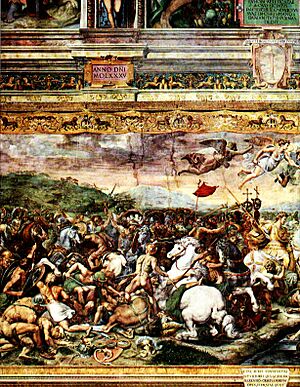Constantinian shift facts for kids

The Constantinian shift is a term used by some Christian thinkers and historians. It describes big political and religious changes that happened in the 4th century. These changes took place when Emperor Constantine the Great was in charge.
Some people, like Rodney Clapp, believe this shift started as early as the year 200. The term became well-known because of the Mennonite theologian John H. Yoder. He argued that the change was more than just Christians gaining freedom from being persecuted. He believed it became an alliance between the government and the Church. This led to a situation where the emperor had a lot of power over church matters, sometimes called Caesaropapism.
However, not everyone agrees that a "Constantinian shift" truly happened. For example, Peter Leithart suggests there was only a "brief, unclear 'Constantinian moment'" in the 4th century. He argues there was "no permanent, huge 'Constantinian shift'."
How Christianity Changed
Constantine the Great ruled from 306 to 337 AD. He became a Christian after winning the Battle of Milvian Bridge in 312. The next year, in 313, he and his fellow emperor, Licinius, issued the Edict of Milan. This important document made Christianity legal in the Roman Empire, alongside other religions.
In 325, the First Council of Nicaea was held. This meeting helped unite Christianity under one main set of beliefs, which Constantine supported. At first, some bishops who disagreed with these beliefs were sent away. But later, Constantine brought some of them back.
Then, in 380, Emperor Theodosius I made Christianity the official state religion of the Roman Empire. By 392, Theodosius passed laws that stopped all pagan religious practices.
During the 4th century, the relationship between the church and the government was not always smooth. Emperors sometimes exiled important bishops who held different Christian beliefs. For example, Athanasius was exiled several times.
Towards the end of the century, a powerful bishop named Ambrose of Milan showed the church's growing influence. He made Emperor Theodosius I do penance for several months after a terrible event in Thessalonica in 390. Theodosius had to show he was sorry before he could take part in church services again. However, other church leaders, like Chrysostom, who criticized the royal court, were later banished and died while traveling to their exile. This shows the changing power balance.
What This Meant for Christianity
Many who criticize the idea of the church being closely tied to the government often see Constantine's time as the start of Caesaropapism. This means the government had too much control over the church. They argue that official Christianity became a way to support and expand worldly political power. This idea helped create Christian empires, both in Rome and later.
Some Christian anarchists believe this shift was a "Great Apostasy." They think it changed Christianity into a tool for rulers to keep their power and to justify violence.
Another important change was how people became Christians. Before, it was seen as a personal choice. After the shift, being a Christian became more connected to being a good citizen in society. American theologian Stanley Hauerwas notes that this shift helped shape how Christianity is seen in America today. He says it became closely linked with patriotism and national identity.
See also
- Antichrist
- Constantinianism
- Christianity in the Roman Empire
- Divine right of kings
- Donation of Constantine
- Erastianism
- Great Apostasy
- Historicism (Christianity)
- Persecution of pagans in the late Roman Empire
- Sacralism

